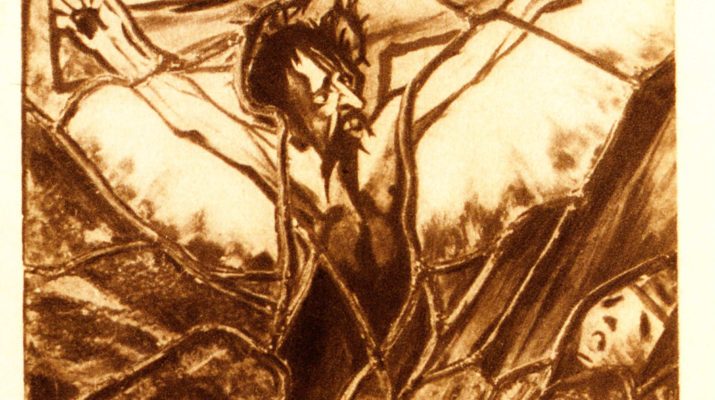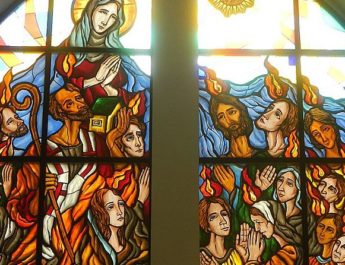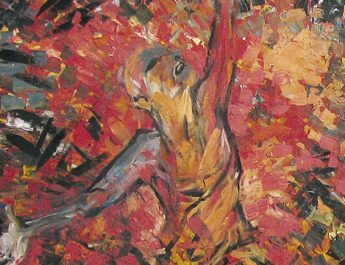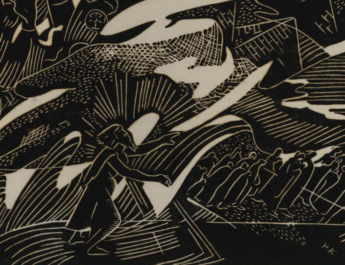John 19:23-30
Narrative Lectionary 437
23 When the soldiersA had crucifiedB Jesus,C
A “soldiers” = stratiotes. From stratia (army; used figuratively for large organized groups like the angels and the hosts of heaven, which is to say the stars); from the same as strateuo (to wage war, fight, serve as a soldier; used figuratively for spiritual warfare); or from the base of stronnuo (to spread, to spread out like a bed). This is a soldier in a literal or figurative sense.
B “crucified” = stauroo. From stauros (upright stake, cross; literally the horizontal beam of a Roman cross, generally carried by the one convicted to die); from the same as histemi (to stand, cause to stand). This can be to attach someone to a cross or fencing with stakes. In a figurative sense, it could be to destroy, mortify, or subdue passions/selfishness.
C “Jesus” = Iesous. From Hebrew Yehoshua (Joshua, the Lord is salvation); {from YHVH (proper name of the God of Israel; the self-existent and eternal one); {from havah (to become) or from hayah (to come to pass, become, be)} + yasha (to deliver, defend, help, preserve, rescue; properly, to be open, wide or free, which implies being safe. So, in a causative sense, this is to free someone)}. This is Jesus or Joshua in Greek – the Lord saves or the Lord is salvation.
they tookD his clothesE and dividedF them into fourG parts,H oneI for each soldier.
D “took” = lambano. It does not refer to passive receiving of something, but active acceptance or taking of something whether it is offered or simply nearby. It focuses on individual decision and action.
E “clothes” = himation. From heima (garment) OR from ennumi (to put on). This is the outer garment, cloak, robe, or mantle. It is worn loosely over a tunic.
F “divided” = poieo. This is to make, do, act, construct, abide, or cause.
G “four” = tessares. This is four – used figuratively for total coverage.
H “parts” = meros. From meiromai (to get your allotment or portion). This is a part, a share, or a portion.
I “one” = meros. Same as “parts” in v23. See note H above.
They also took his tunic;J now the tunic wasK seamless,L
J “tunic” = chiton. 11x in NT. From a Semitic language – see Hebrew kethoneth (tunic). Root means to cover. This is the garment worn beneath the cloak or robe – the one that is closest to the skin.
K “was” = eimi. This is to be or exist.
L “seamless” = arraphos. 1x in NT. Related to araphos (seamless, unsewn); {from a (not, without) + rhapto (to sew) or the same as rhapis (needle); perhaps related to rhapizo (to hit with a rod or to slap); from a derivation of rhabdos (staff, rod, cudgel; a staff that denotes power, royalty, or authority); from rhepo (to let fall, to rap)}. This is seamless or made from a single piece.
wovenM in one pieceN from the top.O
M “woven” = huphantos. 1x in NT. From huphaino (to weave). This is woven or knitted.
N “one piece” = holos. This is whole, complete, or entire. It is a state where every member is present and functioning in concert. This is the root of the word “whole.”
O “top” = anothen. 13x in NT– this is the word used in John 3:3 in the being born “from above”/“again” conversation between Jesus and Nicodemus. From ano (up, above, up to the top, things above, heaven); from ana (up, upwards, again, back, among, anew). This is from above, from the top, again, beginning, from the source. It implies anew.
24 So they said to one another, “Let us not tearP it, but cast lotsQ for it to see who will getR it.” This was to fulfillS what the scriptureT says,U
P “tear” = schizo. 11x in NT. This is to split, divide, tear, sever; split in a literal or figurative sense. This is where the word “schism” comes from and also “schizophrenia” (literally “split mind”).
Q “cast lots” = lagchano. 4x in NT. This is to choose by lot, to receive, determine.
R “get” = eimi. Same as “was” in v23. See note K above.
S “fulfill” = pleroo. From pleres (to be full, complete, abounding in, occupied with). This is to fill, make full or complete. Properly, this is filling something up to the maximum extent that it can be filled – an appropriate amount for its individual capacity. So, this is used figuratively for furnish, influence, satisfy, finish, preach, perfect, and fulfill.
T “scripture” = graphe. From grapho (to write). This is literally writing, a document. In the New Testament, this is always used for scripture.
U “says” = lego. This is to speak, say, name, call, command. It is generally to convey verbally.
“They dividedV my clothes among themselves,
and for my clothingW they castX lots.”Y
V “divided” = diamerizo. Related to “parts” in v23. 12x in NT. From dia (through, across to the other side, thoroughly) + merizo (to divide, part, share, distribute, assign; figuratively, to differ); {from meros (see note H above)}. This is to divide up, distribute, or share. Figuratively, it can mean dissension.
W “clothing” = himatismos. Related to “clothes” in v23. 6x in NT. From himatizo (to clothe, dress, give clothing); from himation (see note E above). This is clothing, apparel.
X “cast” = ballo. This is to throw, cast, rush, place, or drop. It is throwing, but it could be with more or less velocity and with more or less force/violence.
Y “lots” = kleros. 12x in NT. Perhaps from klero (casting a lot) or from klao (to break in pieces as one breaks bread). This lot, portion, heritage. It is that share assigned to you. It could also refer to a lot used to determine something by fate, chance, or divine will.
25 AndZ that is what the soldiers did.AA Meanwhile, standingBB near the crossCC of Jesus were his mother,DD
Z {untranslated} = men. This is truly, indeed, even, in fact. Often, it is not translated, but used to emphasize affirmation.
AA “did” = poieo. Same as “divided” in v23. See note F above.
BB “standing” = histemi. Related to “crucified” in v23. See note B above.
CC “cross” = stauros. Related to “crucified” in v23 & “standing” in v25. See note B above.
DD “mother” = meter. This is mother in a literal or figurative sense.
and his mother’s sister,EE MaryFF the wife of Clopas,GG and Mary Magdalene.HH
EE “sister” = adelphe. From adelphos (brother in a literal or figurative sense); {from a (with, sharing) + delphus (womb)}. This is sister in a literal or figurative sense.
FF “Mary” = Maria. From Hebrew Miryam (Aaron and Moses’s sister); from marah (to be contentious, rebellious, bitter, provoking, disobedient; to be or make bitter or unpleasant; figuratively, to rebel or resist; causatively to provoke). This is Miriam or Mary.
GG “Clopas” = Klopas. 1x in NT. From Aramaic (Clopas); from halap (to make a transition, exchange, renew). This is Clopas. See https://www.abarim-publications.com/Meaning/Clopas.html#.XnjyXahKhPY
HH “Magdalene” = Magdalene. 12x in NT. From Magdala (Magadan, a place near the Sea of Galilee); perhaps from Aramaic migdal, see also Hebrew migdal (tower); from gadal (to grow, grow up, be great). This is from Magdala.
26 When Jesus sawII his mother and the discipleJJ whom he lovedKK standing besideLL her,
II “saw” = horao. To see, perceive, attend to, look upon, experience. Properly, to stare at and so implying clear discernment. This, by extension, would indicate attending to what was seen and learned. This is to see, often with a metaphorical sense. Can include inward spiritual seeing.
JJ “disciple” = mathetes. From matheteuo (to make a disciple of); from manthano (to learn key facts, gain knowledge from experience; generally implies reflection as part of the learning process); from math– (thinking things through). This is a disciple, learner, or student. It is where we get “mathematics” from.
KK “loved” = agapao. Perhaps from agan (much). This is love, longing for, taking pleasure in. It is divine love or human love that echoes divine love.
LL “standing beside” = peristemi. Related to “crucified” in v23 & “standing” in and “cross” in v25. From para (beside, by, in the presence of) + histemi (see note B above). This is to stand beside, appear, be present, be ready, provide, assist.
he said to his mother, “Woman,MM hereNN is your son.”OO
27 Then he said to the disciple, “Here is your mother.” And from that hourPP the disciple took her into his ownQQ home.
MM “woman” = gune. Perhaps from ginomai (to come into being, to happen, become, be born; to emerge from one state or condition to another; this is coming into being with the sense of movement or growth). This is woman, wife, or bride. This is where the word “gynecologist” comes from.
NN “here” = idou. From eido (to be aware, see, know, remember, appreciate). This is see! Lo! Behold! Look! Used to express surprise and or draw attention to the statement.
OO “son” = huios. This is son, descendant – a son whether natural born or adopted. It can be used figuratively for other forms of kinship.
PP “hour” = hora. This is a set time or period, an hour, instant, or season. This is where the word “hour” comes from.
QQ “own” = idios. This is something that belongs to you or that is personal, private, apart. It indicates a stronger sense of possession than a simple possessive pronoun. This is where “idiot” comes from (denoting someone who hasn’t had formal training or education and so they rely on their own understanding).
28 After this, when Jesus knewRR that allSS was now finished,TT he said (in order to fulfillUU the scripture), “I am thirsty.”VV
RR “knew” = eido. Related to “here” in v26. See note NN above.
SS “all” = pas. This is all or every.
TT “finished” = teleo. From telos (an end, aim, purpose, completion, end goal, consummation, tax; going through the steps to complete a stage or phase and then moving on to the next one). This is to complete, fulfill, accomplish, end.
UU “fulfil” = teleioo. Related to “finished” in v28. From teleios (going through the steps to complete a stage or phase and then moving on to the next one; reaching an end and so being complete or “perfect”; also full grown or mature); from telos (see note TT above). This is finish, accomplish, bring to an end, complete, reach a goal, finish a race, to consummate. It refers to completing stages or phases to get to an ultimate conclusion. It can also mean consecrate or fulfill.
VV “am thirsty” = dipsao. 16x in NT. From dipsa (thirst); from dipsos (thirst). This is thirst in a literal or figurative sense. Can also mean keenly desire.
29 A jarWW fullXX of sour wineYY was standingZZ there.
WW “jar” = skeuos. This is a vessel, object, article, property, a tool. It is an implement or other equipment in a literal or figurative sense. It could also refer to a vessel of mercy or a wife.
XX “full” = mestos. 9x in NT. This is filled with in a literal or figurative sense.
YY “sour wine” = oxos. 6x in NT– all of the crucifixion. From oxus (sharp, eager, quick); probably related to akmen (even now, still, yet); from the same as akmazo (become ripe, reach maturity); from akme (point or edge); related to ake (point). This is sour wine or vinegar. As the lowest grade of Roman wine, it was a common drink for Roman soldiers.
ZZ “standing” = keimai. This is to lie, recline, be set, appointed, destined. It is to lie down literally or figuratively.
So they putAAA a spongeBBB full of the wine on a branch of hyssopCCC and heldDDD it to his mouth.EEE
AAA “put” = peritithemi. 8x in NT. From peri (about, concerning, all around, encompassing) + tithemi (to put, place, set, fix, establish in a literal or figurative sense; properly, this is placing something in a passive or horizontal position). This is to place around i.e. to clothe. Figuratively, it can mean to bestow or to present.
BBB “sponge” = spoggos. 3x in NT– all during the crucifixion. Perhaps related to spoggos (sponge or tonsil) – a “Mediterranean-Pontic Pre-Greek substrate loanword.” This is sponge. See https://en.wiktionary.org/wiki/%CF%83%CF%80%CF%8C%CE%B3%CE%B3%CE%BF%CF%82#Ancient_Greek
CCC “branch of hyssop” = hussopos. 2x in NT. A Semitic word – in Hebrew ezob (hyssop). Hyssop, either a stalk or stem.
DDD “held” = prosphero. From pros (at, to, with, towards, advantageous for) + phero (to bear, bring, lead, make known publicly; to carry in a literal or figurative sense). This is to offer gifts or sacrifices, to bring up.
EEE “mouth” = stoma. Perhaps from tomoteros (sharp, keener); from temno (to cut). This is mouth, speech, language, the tip of a sword, an opening in the ground.
30 When Jesus had receivedFFF the wine, he said, “It is finished.” Then he bowedGGG his headHHH and gave upIII his spirit.JJJ
FFF “received” = lambano. Same as “took” in v23. See note D above.
GGG “bowed” = klino. 7x in NT. This is to slant, rest, recline, approach an end, wear. It can be bend in a literal or figurative sense – to lay down, a day ending, causing an opposing army to flee.
HHH “head” = kephale. This is head or chief. It can be a literal head or, figuratively, a ruler or lord. It can also refer to a corner stone. This is where the word “cephalic” comes from.
III “gave up” = paradidomi. From para (from beside, by) + didomi (give, offer, place, bestow, deliver; give in a literal or figurative sense). This is literally to hand over – hence to deliver, abandon, or betray. It implies a personal involvement.
JJJ “spirit” = pneuma. From pneo (to blow, breath, breathe hard). This is wind, breath, or ghost. A breeze or a blast or air, a breath. Figuratively used for a spirit, the human soul or part of us that is rational. It is also used supernaturally for angels, demons, God, and the Holy Spirit. This is where pneumonia comes from.
Image credit: “eli eli lama sabachtani” by Albert August Plasschaert, 1913.




